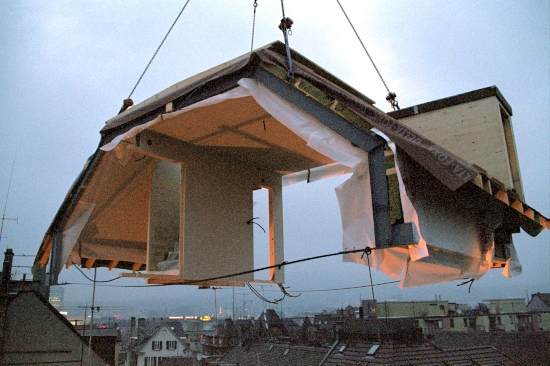The Future Construction platform encourages innovation in the Swiss civil engineering sector
Empa gets to grips with CO2 optimized construction
In Switzerland the construction, operation and maintenance of buildings, as well as their renovation, should in future involve the release of as little CO2 as possible. On the initiative of Peter Richner, the head of the Civil and Mechanical Engineering Department at Empa, the «Future Construction» platform has produced a strategy paper in which the civil engineering industry, building authorities, financial institutions and technical universities undertake with immediate effect to avoid the use of fossil fuel heating and cooling systems when constructing new buildings or renovating old ones. This will be made possible partly through Empa’s innovative building technologies.

|
Caption: The prefabricated roof module during the renovation of a model building, Magnusstrasse, Zurich (Architect: K. Viridén, Zurich).
«The time has come to signal a change of course in the building industry,» maintains Peter Richner, member of the board of directors at Empa, head of the institution’s Civil and Mechanical Engineering Department and member of the executive board of the Future Construction platform. In plain words this means moving away from the use of fossil fuels. The burning of fuel oil, gas and coal creates CO2, which is making a decisive contribution to climate change effects and the global temperature increase. In addition to this, in terms of fossil fuels Switzerland is 100 per cent dependent on imports. According to Richner, this will result in strongly increasing national energy prices as fossil fuel resources threaten to become scarcer. Currently in this country, buildings are responsible for more than half of all carbon dioxide released into the atmosphere. “If we are serious about reducing CO2 emissions in Switzerland we cannot avoid involving the building industry,” explains Richner. And because buildings are replaced or renovated on average every thirty years, rapid action is necessary. The first step towards CO2 optimized construction took place on November 15th at the autumn plenary session of “bauenschweiz” (“Swiss construction”), the umbrella organization of the Swiss building industry. On behalf of the Future Construction platform, Richner presented a strategy paper in which the construction industry, building authorities, financial institutions and technical universities would undertake the following measures:
|
||||
|
Renovating building heating and cooling systems – no solutions at hand According to Richner, as far as the construction of new building is concerned, technologies for CO2 optimization are already widely available, at least in terms technical services. He is therefore calling for standards such as Minergie or Minergie-P for new buildings to be made compulsory. However, such standards and technologies are far more important for renovation work to older buildings, since as a rule new buildings rarely replace older ones with high energy usage and so do not lead to an overall reduction in energy consumption. If, on the other hand, a building dating from the 1970’s were to be renovated to Minergie standards it would thereafter consume only a quarter of the energy originally required for heating and warm water. |
|||
|
However, in some cases renovation work is the very area where practicable solutions are missing. An additional factor is that only a few individual finance institutes offer preferential terms for sustainable renovation work. In the Minergie area Richner feels that a more variegated and aesthetically oriented architectural style is missing. And finally, he describes the “Investor-User Dilemma” as yet another obstacle. This means that a building owner cannot expect his rent income from tenants to completely finance the renovation of the heating system – for example to Minergie standards – even though it is they who benefit entirely from the refurbishment, in that they enjoy more comfort and yet pay less in energy costs. In Richner’s opinion this is a matter which must be dealt with at a political level. On the other hand science, and in particular Empa, is responsible for the technological innovations. |
||||
|
Empa is developing new cladding for old houses An example of this is Empa’s research in the area of high performance insulation materials such as vacuum insulation panels or vacuum glazing. In another project Empa scientists have developed a chemical-based heat storage system which is capable of “preserving” heat collected during the summer for use in the winter months with negligible losses. The system uses sunlight to concentrate a sodium hydroxide solution. When heat is required water is added to dilute the concentrated solution, resulting in the release of stored chemical energy. |
||||
|
Together with other groups from the technical universities, industrial partners and the public authorities, Empa is pursuing a comprehensive solution for renovation work, particularly in the case of multi-family dwellings. The concept behind this project, known as “Sustainable Residential Building Renovation” is simple and clear; the roof of the building being renovated is replaced with an optimized modular roof. The new roof module contains integrated systems which use sun energy and offer comfortable levels of ventilation while the necessary connections – pipework, ventilation ducts and cables etc. – are mounted onto the existing façade, which is, finally, fitted with prefabricated elements such as windows. This project is a part of the brenet – the Swiss national building and renewable energies network of technology – which is supported by the Energy and Mobility Competence Center of the ETH-Domain, the Swiss Federal Office of Energy (SFOE) and the Innovation Promotion Agency (CTI). |
||||
|
Technical Information: Editor: |
||||
|
|||


